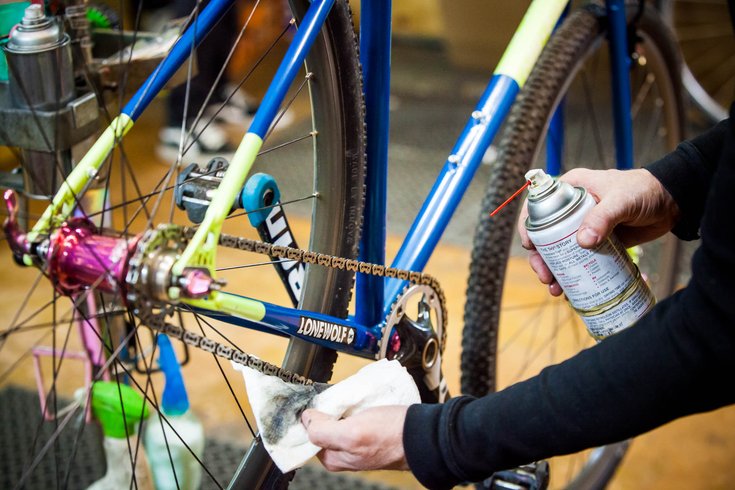
January 19, 2016
 Thom Carroll/PhillyVoice
Thom Carroll/PhillyVoice
Bryan VanArsdale thoroughly cleans his chain with a degreaser before applying a fresh coat of lubricant.
Bryan VanArsdale, the owner of Bicycle Revolutions, knows winter biking. He paid his foul-weather dues as a Philly bike courier in the 90s and is still a year-round cyclist. With years as a mechanic and shop owner under his belt, he’s also an expert on how to keep bikes running smoothly in nasty weather.
RELATED READ: Forecasters: Up to 2 feet of snow possible for the weekend
I caught up with Bryan at his shop at 4th and Fitzwater — which will celebrate its 10th birthday this year — to get his best advice on biking through the winter.
Bryan VanArsdale of Bicycle Revolutions stands proudly with his winter-ready cross bike near his shop in Queen Village.
Yes, I definitely believe so. If you are comfortable and confident riding it, then go for it. You may want to make some alterations as needed: tires, pedals, etc. But go for it, and know your boundaries … or don’t be afraid to fall down. Be sure to plan for it, and wear your helmet.
Tires, pedals, and grips. With tires, you want as much traction as possible, a larger size and grippier tread pattern to allow you to stay upright when it gets snowy, icy and slushy. For pedals, look for ease of entry and a stable platform — allowing for winter riding shoes or boots to keep you as warm and dry as possible.
With grips, use something that will help prevent your hands from slipping and insulate you from the freezing cold metal handlebars. Fenders are great for keeping the slop off of you, but full fenders tend to clog with snow and ice. I recommend clip-on MTB fenders to provide good protection without fear of clogging.
VanArsdale cleans the braking area of his rims with isopropyl alcohol. This in combination with sanding your brake pads will increase the stopping power of your brakes.
Regulate your tire pressure: Running lower pressure in slick conditions will allow you better traction than high pressure, but will require more frequent attention.
Clean and lubricate the chain.
Clean your rims and brake pads, and readjust your brakes.
Grease your seat post (it can be a good reminder to do this at the daylight savings dates to cover the bases). You really don’t want a stuck seat post.
Clean the bike as often as needed. Get off the grit and muck, especially the salt.
Apply a protective bike polish.
After cleaning the frame, VanArsdale applies a polish to protect the bike's finish.
And store/park your bike inside as much as possible. If your bike is locked up outside all day (or night) things like your brake and shift cables and your freewheel/freehub will freeze up, making it very difficult to pedal your bike at all.
It gets very dark very early through the winter, so make sure you can be seen. Around town, use the brightest light you can afford and safely remove and install (when parking, to avoid theft) that will allow you to be seen. If you are commuting outside of the city or into the dark corners or riding unlit trails/paths, then you probably want lights that will run 500 lumens or more to illuminate your path.
Having bright lights and larger, knobby tires will increase the safety of the rider in the winter months.
I use one helmet-mounted light as well as one handlebar-mounted light for safety when riding on the trails. And you definitely need front and rear lights. (Lights are also required by law!)
Ice sucks, and it’s scary. Try to ride in the tire tracks (ruts) as much as possible when streets aren’t cleared or salted, and always expect any wet-looking road to be black ice — because it probably is. Take more space in the road, and be visible. Studded tires can be handy if your bike will accommodate them and conditions are glacial, but they stink to ride on dry pavement.
Once the bike has been cleaned and polished, be sure to have a trusty shop dog give a final inspection before venturing into the winter elements.
[The 1993-1994 season] was my first winter on the road, and it was constant ice storms. I had a crappy mountain bike and was not prepared for what I was getting myself into. I learned quickly about layering up and how to fall gently. I would buy extra warm/dry clothes at I. Goldberg Army & Navy as needed to survive. I worked for Diamond Courier that year and they gave us all special certificates for surviving that winter. It was epic.
With the first big snowfall supposedly around the corner, we’re sure to see some treacherous road conditions. With Bryan’s advice — and a little caution — you can bike year-round with confidence.
 Thom Carroll/PhillyVoice
Thom Carroll/PhillyVoice Thom Carroll/PhillyVoice
Thom Carroll/PhillyVoice Thom Carroll/PhillyVoice
Thom Carroll/PhillyVoice Thom Carroll/PhillyVoice
Thom Carroll/PhillyVoice Thom Carroll/PhillyVoice
Thom Carroll/PhillyVoice